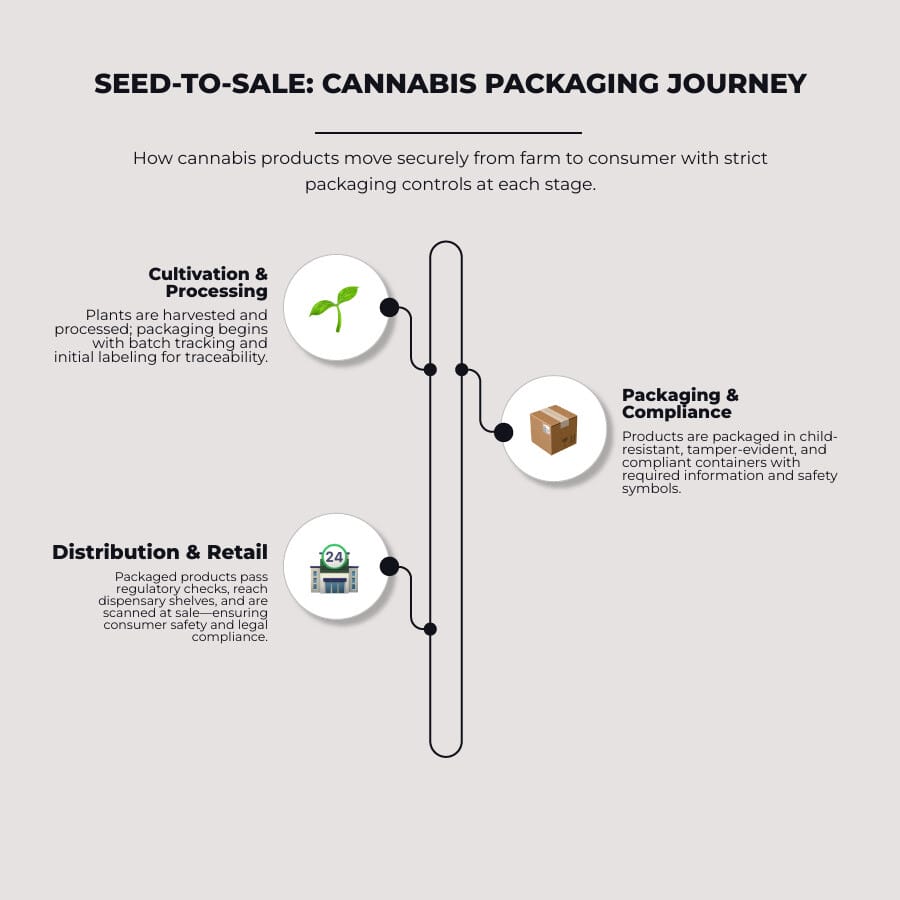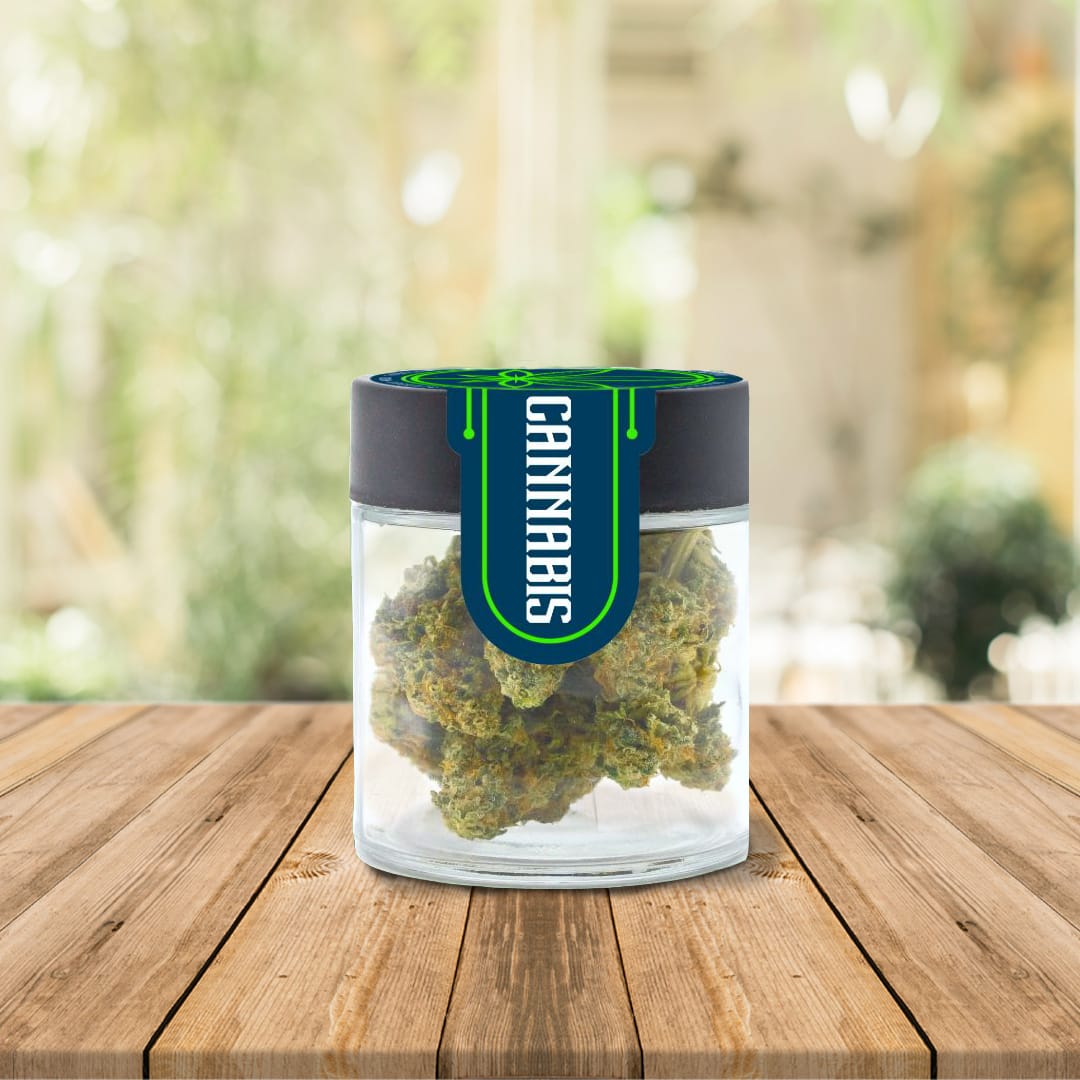Effective Weed Packaging Solutions
Weed packaging is essential for cannabis brands looking to stand out in today’s competitive market while meeting strict regulatory requirements. Here’s what you need to know about cannabis packaging options:
- Child-resistant containers: Required by law in most states
- Compliant labeling: Must include THC/CBD content, warnings, batch numbers
- Materials: Glass jars, mylar bags, pre-roll tubes, concentrate containers
- Customization options: Custom printing, embellishments, unique shapes
- Sustainability: Recyclable, biodegradable, and reusable options
Cannabis packaging serves two critical purposes: protecting your product and showcasing your brand. With packaging often weighing 4 to 30 times more than the product itself, choosing the right materials and designs is both a compliance necessity and a marketing opportunity.
Modern dispensary shelves are crowded with options, making distinctive packaging crucial for capturing consumer attention.
Whether you’re launching a new product line or refreshing existing packaging, your choices need to balance regulatory compliance, brand identity, and environmental responsibility. The right packaging partner can help steer these requirements while creating packaging that resonates with your target audience.
From opaque, child-resistant containers for edibles to terpene-preserving glass jars for premium flower, each product category has specific packaging needs that must be addressed to maintain product quality and meet legal standards.

Top Weed Packaging Options and Materials
The cannabis industry has evolved dramatically in recent years, and with it, so have packaging options. Today’s weed packaging solutions must balance regulatory compliance, product preservation, brand presentation, and increasingly, environmental responsibility.
Flower & Pre-Roll Solutions
When it comes to cannabis flower, preservation of freshness, aroma, and potency is paramount. The packaging you choose directly impacts how long your product maintains its quality.
Glass Jars: Premium brands often choose glass for its superior preservation qualities. Glass is non-reactive, meaning it won’t leach chemicals or affect the flavor profile of your product.
Glass jars typically feature:
- UV protection (amber or opaque options)
- Airtight seals to preserve freshness
- Child-resistant caps that meet CPSC standards
- Space for compliant labeling
- Optional humidity control pack integration
Pop-Top Drams: These plastic containers have become industry standards for their convenience and compliance features. The “pop-top” mechanism satisfies child-resistance requirements while providing easy access for adult users. Many dispensaries appreciate their stackability and standardized sizes.
Pre-Roll Tubes: For pre-rolled products, specialized tubes offer protection and presentation value. The best options include:
- Child-resistant push-and-turn caps
- Moisture barriers to maintain freshness
- Display windows for product visibility
- Custom printing options for branding
- Doob tube designs for single joints
Humidity Control: Many premium packaging solutions now integrate humidity control packs that maintain optimal moisture levels (typically 58-62% relative humidity). These packs ensure your flower doesn’t dry out or develop mold issues during storage and distribution.
Terpene Preservation: Advanced packaging solutions focus on preserving the aromatic terpenes that give cannabis its distinctive smell and contribute to its effects.
Edible & Beverage Containers
Edible cannabis products face some of the strictest packaging regulations in the industry, with most states requiring:
Opaque Pouches: Regulations typically require that edibles be packaged in opaque materials so the product isn’t visible to children. Mylar bags with custom printing have become the go-to solution, offering:
- Child-resistant zipper closures
- Moisture and oxygen barriers
- Heat-sealable options
- Multiple size options for different products
Resealable Zips: For multi-serving edibles, resealable packaging is often required by law.
Aluminum Cans: For cannabis beverages, modified aluminum cans with child-resistant features are becoming increasingly popular. These specialized cans include:
- Proprietary opening mechanisms that satisfy CR requirements
- Familiar form factors that consumers understand
- Extended shelf life for liquid products
- Full-wrap labeling options for branding
Dose Caps: For products like capsules or tablets, specialized bottles with child-resistant caps are essential. These typically include:
- Push-and-turn mechanisms
- Tamper-evident seals
- Desiccant integration options
- Safety liners
Heat-Sealed Films: Many edible manufacturers use heat-sealed films as an additional layer of protection and compliance. These films provide tamper evidence and help maintain product freshness.
Concentrate & Vape Hardware Packaging
Cannabis concentrates and vape products present unique packaging challenges due to their consistency, potency, and sometimes, liquid form.
Silicone-Lined Jars: For sticky concentrates like wax, budder, or shatter, silicone-lined containers prevent product waste and make access easier for consumers.
Blister Clamshells: For cartridges and disposable vapes, custom blister packaging offers protection during shipping and displays the product effectively at retail. These typically feature:
- Child-resistant opening mechanisms
- Clear product visibility
- Custom-cut foam inserts for product stability
- Hanging options for retail display
Anti-Leak Seals: For liquid concentrates and cartridges, preventing leakage is crucial. Advanced packaging includes specialized seals and closures designed specifically for cannabis oils and distillates.
Heat Resistance: Quality concentrate packaging must withstand temperature variations without degrading or affecting the product inside. This is especially important for products that may be exposed to heat during use or storage.
Metal Recyclability: As sustainability becomes more important, many brands are choosing metal containers for concentrates because of their recyclability. Aluminum and tin containers can be easily recycled in most municipal systems, unlike some plastic alternatives.
Designing Compliant and Sustainable Cannabis Packaging

Weed Packaging Compliance Checklist by State
Cannabis packaging regulations vary significantly by state, creating challenges for brands operating across multiple markets. While this regulatory patchwork can seem overwhelming, understanding the common threads can simplify your approach.
Batch and lot numbers aren’t just regulatory checkboxes—they’re essential safety mechanisms.
When it comes to potency labeling, most states recognize the natural variations in cannabis testing by allowing a ±15% variance in listed THC/CBD content. Your labels must clearly communicate cannabinoid content, typically in milligrams or percentage by weight, helping consumers make informed decisions about dosage.
The fine print matters too—literally. Many states mandate minimum font sizes (typically 6-point font or 1/16 inch) for warning statements and product information. This seemingly minor detail can dramatically impact your label design and even determine minimum package sizes.
State-specific requirements add another layer of complexity. Colorado requires RFID tags on certain packages for inventory tracking, while California distinguishes between “primary” and “informational” panels. Florida requires opaque wrapping for all edible products, and Massachusetts mandates tamper-proof containers with specific warning language.
Almost all legal markets require the inclusion of a universal cannabis symbol. While the exact design varies by state, this symbol immediately identifies the package as containing cannabis—a crucial safety feature for households with children. For readers interested in the origins of modern safety closures, see the overview on child-resistant packaging.
Tamper-evident features have become standard across the industry. These features reassure consumers about product integrity.
Perhaps most importantly, weed packaging must be certified child-resistant according to the Poison Prevention Packaging Act standards. This means designing packaging that’s difficult for children under five to open while remaining accessible to adults—a challenging balance to strike.
Many forward-thinking brands now include QR codes linking to batch-specific lab results. This digital bridge improves transparency and builds consumer confidence by providing easy access to detailed product information.
Custom Design Tips to Lift Your Brand
While meeting compliance requirements and sustainability goals, effective weed packaging must also differentiate your products in an increasingly crowded marketplace. Strategic design choices can dramatically impact consumer perception and purchasing decisions.
Color psychology plays a powerful role in silent communication with consumers. Green tones naturally suggest plant-based, natural products, while purple often conveys premium, high-potency offerings. White and clean designs signal pharmaceutical-grade quality, and bold, vibrant colors help differentiate recreational products on crowded shelves.
Tactile Coatings in Printing: Enhancing the Print Experience Through Touch
Tactile coatings add a physical texture to printed materials, creating a more engaging sensory experience. Commonly used in packaging, labels, and secure documents, these coatings elevate brand perception and improve product functionality.
Types of Tactile Coatings
- Soft-Touch Coatings: Deliver a velvety, high-end feel—ideal for luxury packaging.
- Textured or Grit Coatings: Add a coarse finish for industrial use or security features.
- Raised Image Coatings: Provide a high-relief effect that makes visuals pop.
- Soft-Touch UV Coatings: Fast-drying, scuff-resistant, and silky smooth.
- Aqueous Coatings: Water-based with matte or gloss finishes and special effects.
- Embossing (not a coating): Raises areas of the material for added texture and visual interest.
Benefits of Tactile Coatings
- Enhanced Engagement: Invites touch, increasing customer interaction and brand recall.
- Premium Look & Feel: Adds sophistication to packaging and printed pieces.
- Improved Functionality: Offers grip or resistance where needed.
- Added Security: Hard-to-replicate textures deter counterfeiting.
- Durability: Protects against wear, scuffs, and fingerprints.
- Versatility: Compatible with paper, plastic, and foils.
- Custom Application: Available as full or spot coatings for tailored designs.
Common Applications
- Packaging: Cosmetics, luxury goods, food, pharmaceuticals.
- Labels: Products requiring visual and tactile appeal.
- Secure Documents: Currency, gift cards, legal papers.
- Printed Collateral: Business cards, brochures, invitations, photo books.
The feel of your packaging matters just as much as its appearance. Tactile coatings create a multisensory experience that lifts perceived value. These finishes create memorable moments when customers handle your products.
For more guidance on selecting the right labels for your cannabis products, explore our resource on How to Choose the Right Labels for Cannabis Packaging or learn about Custom Cannabis Labels: How to Make Your Product Stand Out.
Work with Weed Packaging Experts
Working with Whitlam Group as your single-source partner significantly benefits your packaging strategy. Our deep expertise in navigating complex regulatory requirements means you can focus on building your brand while we handle the compliance details. Our 65+ years in the industry and advanced printing capabilities help your products stand out on crowded dispensary shelves through distinctive visual branding that captures attention.
We ensure consistency across your entire product lineup and in multiple markets, creating a cohesive brand experience for your customers. Our streamlined production processes mean faster turnaround times and fewer headaches for you. Plus, you’ll have access to the latest sustainable materials and technologies as the industry increasingly moves toward environmental responsibility.
